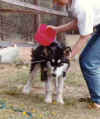|
Grooming
The Malamute is a breed requiring less grooming and general maintenance than
most people think, and tend to keep themselves clean by grooming themselves like
a cat. Being an arctic breed, the Malamute has evolved to be able to keep clean
without needing to get wet to do so, as in an arctic environment getting wet in
winter would mean freezing to death.
 The
Malamute therefore needs fairly minimal washing as most of the dirt in the coat
will brush out, and if the coat and skin are healthy there should not be any
"doggy" odour. Our Malamutes get covered in mud and dirt during sledding and
backpacking, but will be quite clean the next day without any intervention on
our part, or in extreme cases may need just a little brushing. The
Malamute therefore needs fairly minimal washing as most of the dirt in the coat
will brush out, and if the coat and skin are healthy there should not be any
"doggy" odour. Our Malamutes get covered in mud and dirt during sledding and
backpacking, but will be quite clean the next day without any intervention on
our part, or in extreme cases may need just a little brushing.
The
Malamute's sensitive skin can develop fungal infections if washed too
often as the protective oils are removed from the coat and skin by
shampoos and soaps, no matter how mild. A good brushing on a regular
basis should be enough to keep the Malamute's coat in good condition in
most cases, however the amount of brushing required will increase
dramatically during shedding time.
Of
course if you show your dog you will need to present it at it's cleanest, but if
you show regularly you may only need to wash the "whites" and not the
whole dog every time. Use a mild soap suitable for sensitive skins, and
make sure all the soap gets thoroughly rinsed out of the coat.
The
Malamute's "spring cleaning" takes form of a massive shedding of the
undercoat, which mostly occurs twice a year in bitches and once a year in
males. A desexed Malamute lacks the hormonal influence that controls this
cycle, and for this reason is more likely to have a thicker coat and shed a bit
of undercoat all year round as well as having a major shedding time.
 Left:
An "out of coat" Malamute can look most unimpressive! Left:
An "out of coat" Malamute can look most unimpressive!
During
those few weeks of coat drop everything - your clothing, yard, car, etc.
- becomes decorated with a layer of the woolly Malamute undercoat. At
this time the Malamute will need to be groomed daily with a special
undercoat
rake to assist with removal of the dead coat, and will look most
unimpressive when all the undercoat has been removed. The
undercoat will slowly grow back but it can be 8 to 10 weeks before the
Malamute regains the full coat.
If
the shedding undercoat is not removed regularly the dead hair will become
matted, thus reducing the airflow to the skin and providing the ideal
environment for skin infections to take hold. Any strong, persistent
"doggy" odour requires investigation - it is not normal in a Malamute
and is often a sign of skin or other health problems.
As
with all dogs, the Malamute's toenails will need clipping - this should be done
on a regular basis and definitely not just once a year at the vets. The
frequency of toenail clipping required depends on the rate of growth and the
surface on which the Malamute is housed and walked, but the more often you do it
the more your Malamute will come to accept it. Our Malamutes have their nails
clipped frequently, which ensures that it's no big drama for them when the nail
clippers come out. A bit bribery in the form of food also helps convince
them that nail clipping is not so bad after all!
 When
you cut the nails be sure not to cut into the quick, which is the area
of the nail in which there are blood vessels and nerve endings. If you
do this just once your Malamute will remember it for a long time and may
well put up a struggle next nail-clipping time. If you find it difficult
to determine where the quick begins, hold the toenail in front of a
light - I use a torch to backlight the nail if I am having trouble
seeing how much needs to be cut off. When
you cut the nails be sure not to cut into the quick, which is the area
of the nail in which there are blood vessels and nerve endings. If you
do this just once your Malamute will remember it for a long time and may
well put up a struggle next nail-clipping time. If you find it difficult
to determine where the quick begins, hold the toenail in front of a
light - I use a torch to backlight the nail if I am having trouble
seeing how much needs to be cut off.
During
the colder months when our dogs are working we allow the nails (with the
exception of the dew claw) to grow a bit longer than during the summer months.
The slightly longer nails give the dog increased traction when running in
harness or hiking, especially on slippery trails or in snow. The dew claws
should always be kept fairly short - rear dew claws should be removed by a
veterinary surgeon.
There
are two types of nail clipper - the guillotine type and the plier-type
nail clipper. We use the plier-type as they are stronger and we
find they give you a better view of the nail as you are cutting.
Written
by Sandy Koch, Windchill Kennels. |